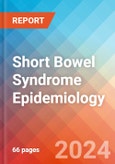Key Highlights
- In the 7MM, the highest prevalent cases of short bowel syndrome were in the United States, accounting for nearly 14,000 cases in 2023.
- Germany had the highest number of prevalent cases of short bowel syndrome among the EU4 and the UK, followed by the UK, whereas Spain had the lowest number of cases in 2023.
- In 2023, Japan accounted for roughly 900 cases in adults and 150 cases in pediatric population.
- Several conditions requiring intestinal resection may lead to SBS. To date, resurgery performed for complications following a previous abdominal operation is one of the leading causes of SBS in adults and accounts for up to 50% of patients.
Geography Covered
- The United States
- EU4 (Germany, France, Italy, and Spain) and the United Kingdom
- Japan
Study Period: 2019-2032
Short Bowel Syndrome Disease Understanding and Diagnosis
Short Bowel Syndrome Overview
Short bowel syndrome is a complex disease that occurs due to the physical loss or the loss of function of a portion of the small and/or large intestine. Consequently, individuals with short bowel syndrome often have a reduced ability to absorb nutrients such as fats, carbohydrates (sugars) vitamins, minerals, trace elements and fluids (malabsorption). The specific symptoms and severity of short bowel syndrome vary from one person to another. Diarrhea is common, often severe and can cause dehydration, which can even be life threatening. Short bowel syndrome can lead to malnutrition, unintended weight loss and additional symptoms may be due to the loss of essential vitamins and minerals. There is no cure, but the disorder usually can be treated effectively. However, in some cases, short bowel syndrome can lead to severe, disabling and life-threatening complications.Short Bowel Syndrome Diagnosis
A diagnosis of short bowel syndrome is made based upon a detailed patient history, a thorough clinical evaluation and a variety of specialized tests including laboratory tests and X-ray studies.A health care provider diagnoses SBS based on a medical and family history, a physical exam, blood tests such as CBC, albumin, creatinine tests, and others. Fecal fat tests is also performed, which can show how well the small intestine is working. Imaging techniques may be used to assess individuals with short bowel syndrome. Such tests include plain abdominal X-rays to detect signs of obstruction or ileus (paralysis of intestinal muscles), computerized tomography (CT) scanning of the abdomen (abdominal CAT scan), magnetic resonance imaging (MRI) of the abdomen or an abdominal ultrasound. Upper GI series, also called a barium swallow, uses X-rays and fluoroscopy to help diagnose problems of the upper GI tract.
Short Bowel Syndrome Epidemiology
The short bowel syndrome epidemiology chapter in the report provides historical as well as forecasted epidemiology segmented by prevalent cases of home parenteral nutrition (HPN), diagnosed prevalent cases of short bowel syndrome, age-specific cases of SBS, gender-specific cases of SBS, etiology-specific cases in the 7MM covering the United States, EU4 countries (Germany, France, Italy, and Spain), United Kingdom, and Japan from 2019 to 2032.- In the 7MM, the highest prevalent cases of short bowel syndrome were seen in the United States, followed by EU4 and the UK in 2023.
- Short bowel syndrome is more common in females as compared to males. In the United States, more than 67% of short bowel syndrome patients were female.
- In the United States, around 29% and ~24% short bowel syndrome cases were caused by surgical complications and mesenteric infarction respectively in 2023.
- In EU4 and the UK, Germany accounted for the highest prevalent cases of short bowel syndrome, while Spain accounted for the least prevalent cases in 2023.
Scope of the Report
- The report covers a segment of key events, an executive summary, descriptive overview of short bowel syndrome, explaining its causes, signs and symptoms, pathogenesis, and diagnostic approaches.
- Comprehensive insight has been provided into the epidemiology segments and forecasts, the future growth potential of diagnosis rate, and disease progression.
- A detailed review of the short bowel syndrome epidemiology, detailed assumptions, and rationale behind our approach is included in the report.
- A detailed review of current challenges in establishing the diagnosis.
Short Bowel Syndrome (SBS) Report Insights
- Patient Population
- Patient population by gender, etiology, and age
- Country-wise Epidemiology Distribution
Short Bowel Syndrome (SBS) Report Key Strengths
- Eleven Years Forecast
- The 7MM Coverage
- Short Bowel Syndrome Epidemiology Segmentation
Short Bowel Syndrome (SBS) Report Assessment
- Epidemiology Segmentation
- Current Diagnostic Practices
Key Questions
Epidemiology Insights:
- What are the disease risk and burdens and of short bowel syndrome? What will be the growth opportunities across the 7MM with respect to the patient population pertaining to short bowel syndrome?
- What is the historical and forecasted short bowel syndrome patient pool in the United States, EU4 (Germany, France, Italy, and Spain), the United Kingdom, and Japan?
- Which age group is the largest contributor in patients affected with short bowel syndrome?
- What factors affect the increase in the patient number in later lines of short bowel syndrome therapy?
Reasons to Buy
- Insights on patient burden/disease prevalence, evolution in diagnosis, and factors contributing to the change in the epidemiology of the disease during the forecast years.
- To understand Key Opinion Leaders’ perspectives around the accessibility, acceptability, and compliance-related challenges of existing treatment to overcome barriers in the future.
- Detailed insights on various factors hampering disease diagnosis and other existing diagnostic challenges.








